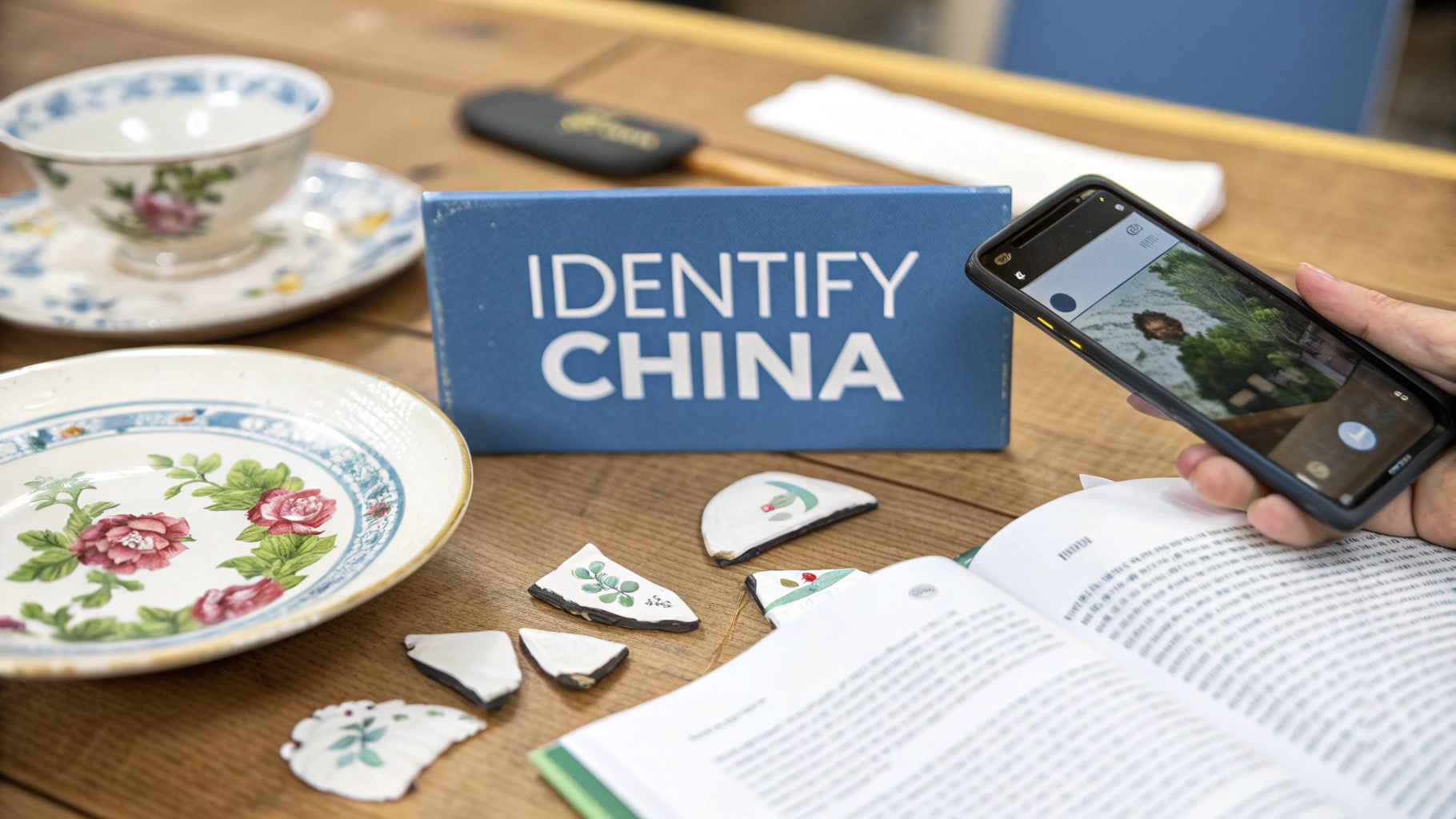When you want to figure out what kind of china you're holding, the first move is always the same: turn it over. The small stamp on the bottom, known as a backstamp or maker's mark, is your single best clue. It's the starting point for uncovering who made your piece, where it came from, and roughly how old it is.
Start with the Backstamp: Your First Clue
Think of the backstamp as the artist's signature on a painting. Without it, you’d be lost in a sea of millions of possibilities. This little mark, whether it's a simple name, a detailed crest, or a tiny symbol, is your Rosetta Stone. It immediately narrows your search from countless patterns down to the catalog of just one manufacturer.
Finding that mark is your "aha!" moment. It's what puts you on the right track and turns a frustrating search into a fun treasure hunt.
Decoding the Marks
Once you’ve found the backstamp, you need to figure out what it’s telling you. Most of the time, you'll see a printed mark in a single color like green, blue, or black. Sometimes, you'll find hand-painted marks, which often suggest an older or more unique item.
Don't forget to look for impressed marks, too. These are stamped right into the clay before the piece was fired. They can be really faint, so you’ll often need to tilt the dish under a good light to catch the shadow.
The symbols on backstamps are packed with meaning. A crown, for instance, often points to a pottery that supplied a royal family or simply wanted to project an image of superior quality. A lion is a classic symbol of strength and is a common sight on pieces from English potteries.
Many marks give you the country of origin right away, with phrases like "Made in England" or "Limoges, France." Some even include patent numbers or sneaky date codes that can help you pinpoint the exact year of production. This context is crucial, especially as global manufacturing has changed so much.
For instance, the global ceramics industry looks very different today than it did a century ago. According to a report from the Rhodium Group, China's manufacturing export share climbed to 53.5% as of February 2025, a significant jump from 35.5% just a decade earlier. Knowing when and where your piece was made helps place it within this larger history.
Common Types of Maker's Marks and What They Mean
To help you get started, here’s a quick guide to the different kinds of backstamps you're likely to encounter. This table breaks down what they look like and the clues they offer.
| Mark Type | Description | What It Tells You |
|---|---|---|
| Printed Mark | A logo, name, or symbol transferred onto the piece, often in a single color. The most common type. | Usually indicates the company name and sometimes the country of origin. The style can help date the piece. |
| Hand-Painted Mark | Markings applied by hand with a brush. Often less uniform than printed marks. | Can signify an earlier piece, a studio pottery, or a special decorator's mark. |
| Impressed Mark | A mark pressed into the wet clay before firing. Can be a name, symbol, or number. | Often one of the earliest forms of marking. Can be subtle and easy to miss. |
| Mark with a Date Code | A mark that includes letters, numbers, or symbols that correspond to a specific production year. | The most precise way to date a piece. You'll need a manufacturer-specific guide to decode it. |
| Retailer's Mark | Sometimes, the mark belongs to the high-end retailer (like Tiffany & Co.) that sold the china, not the maker. | Tells you where it was sold, which implies a certain level of quality. You may need to do more digging to find the actual pottery. |
Familiarizing yourself with these types will make your research much faster. Once you know what kind of mark you're looking at, you'll have a much better idea of where to look next for answers.
Taking Clear Photos for Accurate Identification
When you're trying to identify a china pattern online, a blurry photo is your worst enemy. It's the single biggest roadblock to getting a quick and accurate answer. The good news? You don't need a professional camera setup. Your smartphone is more than up to the task if you get a couple of things right.
The two most important elements are natural light and a neutral background. Find a plain, solid-colored surface to work with—a simple white sheet, a piece of poster board, or even a clean wooden tabletop works perfectly. Steer clear of busy tablecloths or cluttered backgrounds that will only confuse visual search tools and human experts alike.
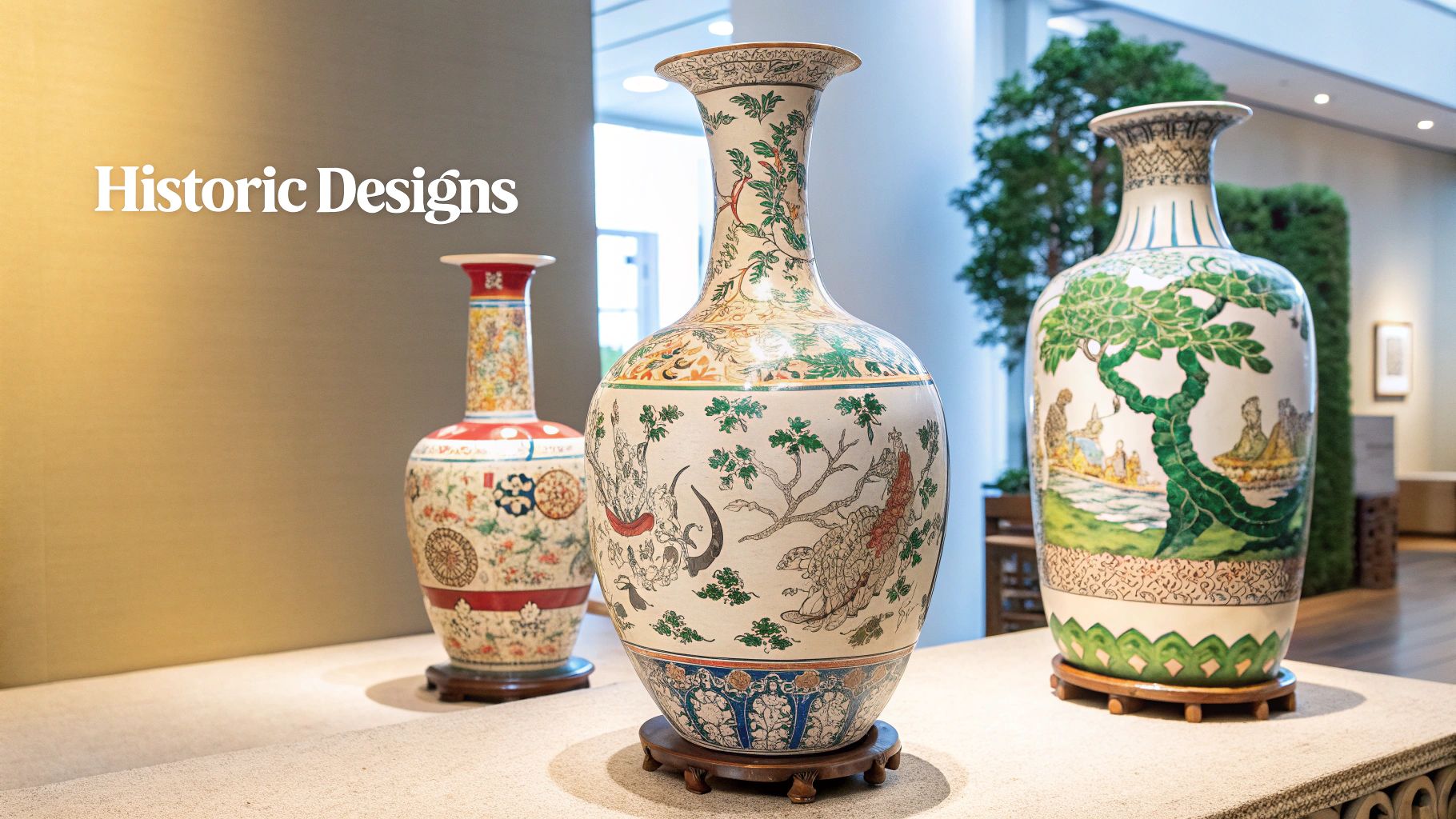
Try to set up near a window where you can get plenty of soft, indirect daylight. This kind of light reveals the true colors of the china without causing harsh glare or deep shadows. If you're getting annoying reflections off a glossy glaze, shift your angle slightly instead of shooting straight down from above.
The Three Essential Shots
To set yourself up for success, you'll need three specific photos. I always tell people to think of these as the "must-haves" that tell the full story of your piece.
- The Full Picture: Get a shot of the entire item. For a plate, that means the whole plate. For a teacup, get the cup and saucer together. This gives a sense of the overall shape and how the pattern is laid out.
- A Pattern Close-Up: Now, zoom in on a prominent part of the design. Focus on a particular flower, bird, or geometric detail. This is what helps you spot the subtle differences between similar patterns.
- The Maker’s Mark (Crystal Clear): This is the most important photo of all. The backstamp needs to be in sharp focus, perfectly readable, and brightly lit. No excuses here!
Taking great photos is a foundational skill for any collector. In fact, these same principles apply when you learn how to identify antiques of any type, whether it's furniture, glassware, or silver.
If you're working with older photos you can't retake, you could also look into using AI image enhancement techniques to sharpen them up and make those crucial details easier to see.
Taking Your Search Online
Once you have clear photos, it's time to put the internet to work. A simple web search probably won't cut it, so you'll want to head straight to the specialized tools the pros use. This is where you'll get the fastest, most accurate results.
Your first stop should be a visual database built for this exact task. My personal favorite, and a giant in the industry, is Replacements, Ltd. They have an incredible catalog with thousands of manufacturers. You can use their "Identify" service to send in your photos, and their experts will try to find a match in their records. Honestly, this is often the quickest way to get a definitive answer.
The process is straightforward. They'll ask you to upload specific shots—the front, the back, and a close-up of the maker's mark—to give their team everything they need.
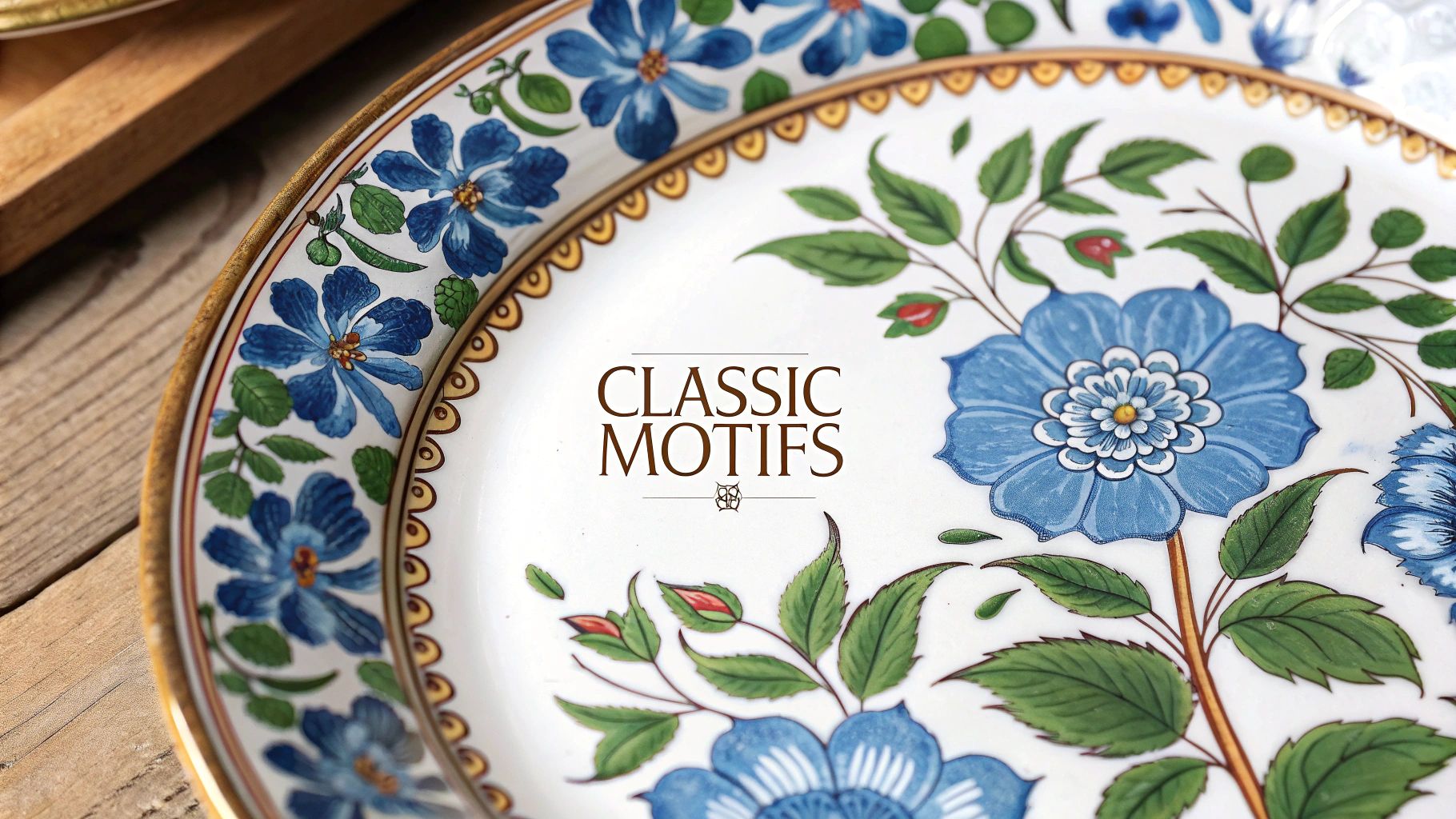
How to Craft a Killer Search Query
If you'd rather do the sleuthing yourself, your success will come down to how you search. "Old floral china" is too vague and will give you millions of useless results. You need to combine the details you've gathered from the piece itself.
Think like an expert. Your search should be descriptive and precise. For example:
- "Haviland Limoges pink roses gold scalloped edge"
- "Spode Copeland Tower blue transferware dinner plate"
- "Noritake Morimura Bros wreath backstamp gold trim"
See the difference? This approach cuts through the noise and gets you to the right listings and articles much faster.
Pro Tip: Don't forget about Google's reverse image search. Upload that crisp, clear photo of the pattern. Google will scour the web for visually similar images, which can be an amazing shortcut to finding your exact pattern on collector sites, forums, or old sale listings.
Even general online marketplaces can be treasure troves of information. I often browse them just to see what other sellers are calling a similar piece. If you spend time on platforms like Facebook Marketplace, picking up some advanced search tips for online marketplaces will help you find those hidden-gem listings that hold the clues you're looking for.
Don't Forget the Bookshelves: Using Printed Guides
As great as online searches are for quick answers, sometimes the most reliable information for identifying a china pattern is tucked away in a good old-fashioned book. When you’re dealing with a truly rare, antique, or obscure piece, a well-researched guide offers a level of authority that a quick web search just can’t replicate. These books are often the culmination of someone's lifelong passion and scholarship.
Think of these guides as the definitive catalogs for their niche. I’ve found them invaluable for cross-referencing a tricky backstamp, getting a close-up look at pattern details, and really understanding a manufacturer’s history. There's something about having the book open next to the plate that makes side-by-side comparison so much easier than flipping between browser tabs.
Essential Guides for Your Bookshelf
Over the years, certain reference books have become the go-to resources for collectors and dealers alike. If you're getting serious about identifying china, these are some great additions to your toolkit:
- Kovels' Antiques and Collectibles Price Guide: This is an annual publication that gives a fantastic overview of the market, covering many popular china patterns. It's a perfect starting point.
- Manufacturer-Specific Encyclopedias: For a deep dive, look for books focused on a single maker. I have go-to guides on my shelf like "The Collector's Encyclopedia of Noritake" and others dedicated to Wedgwood, Spode, or Haviland. The detail in these is incredible.
- Backstamp Dictionaries: A book like "Kovels' Dictionary of Marks - Pottery & Porcelain" is an absolute must-have. It’s like a Rosetta Stone for decoding the symbols, dates, and names you'll find on the bottom of your china.
Pro Tip: Don't feel like you need to spend a fortune building a library overnight. Your local library is an amazing, and often overlooked, resource. Many carry these specialized reference books, giving you access to a wealth of expert information for free. A quick search of your library's online catalog can save you hundreds of dollars.
With these resources in hand, you can sit down and methodically look up a manufacturer, flip through pages of illustrations to find a visual match, and confirm those tiny details that online sources sometimes get wrong. This classic approach remains one of the most dependable ways to identify a china pattern with real confidence.
Getting the Details Right: A Final Confirmation
You’ve done the research and you think you have a name for your pattern. Great! But hold on—the final step is arguably the most important. You need to confirm it’s an exact match. Manufacturers were notorious for creating dozens of patterns that looked almost identical, with only the tiniest differences. This is where a sharp eye for detail really pays off.
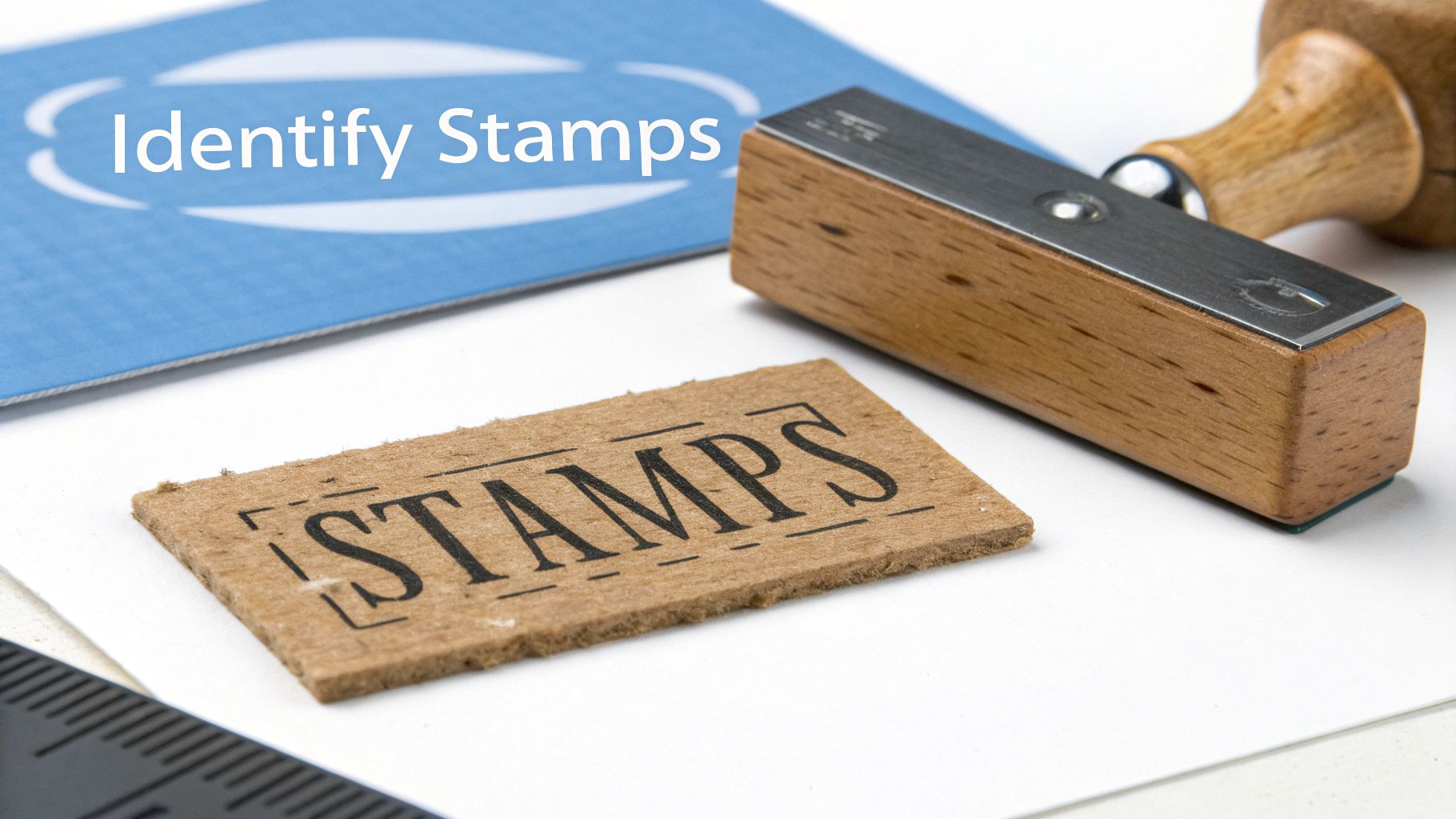
Put your piece right next to a high-quality reference photo of the pattern you've identified. It’s time to play detective. Scrutinize every single element. Are the colors truly the same? Is that blue a deep navy, or is it leaning more toward a royal blue? These subtle nuances make all the difference. This same meticulous approach is just as useful when you're trying to identify antique furniture and its period details.
What to Look For
Focus on the tiny details that separate one specific design from its very similar cousins. These are the things that truly define a pattern.
- Floral and Image Specifics: Don’t just settle for “roses.” Are they fully open blooms or tight buds? Do they have leaves, and if so, what’s their shape? Every petal and leaf counts.
- Metallic Trim Style: That gold or platinum edge is a massive clue. Is it a solid, smooth band? Maybe it’s a delicate, brushed line. Or perhaps it has a more complex edge, like scallops, dots, or a gadrooned (roped) texture.
- Embossed Details: Gently run your fingers over the rim and the body of the piece. Can you feel any raised or indented patterns in the china itself? Look for subtle swirls, dots, or ridges that are part of the mold, not the painted design.
A perfect real-world example is telling the difference between Royal Albert’s iconic "Old Country Roses" and its countless imitators. The true pattern is defined by a very specific shade of red in the rose, the unique gold sponging on the edge, and the gentle curves of the handle. Getting these details right is how you spot the real deal.
Understanding where your china was made can also give you context for its design. This is especially true given China's long history and modern dominance in ceramics and trade. In fact, as of 2024, China has become the primary trading partner for an incredible 70% of the world's economies, a testament to its global economic influence. You can read more about China's global economic share on Statista.
What to Do When You Can’t Find the Pattern
So you've hit a wall. It happens to everyone, and it’s one of the most frustrating parts of identifying old china. But don't toss in the towel just yet. When you can’t find a pattern using the usual methods, it doesn't mean it's unidentifiable—it just means you probably have something a little unusual on your hands.
More often than not, these mystery patterns weren't created for the general public. You might be looking at an exclusive design made for a hotel chain, a cruise line, or a restaurant. It could also be a short-run pattern sold only through a specific department store, or even a test piece that the factory never put into full production. Many older makers also churned out thousands of designs that were only ever identified by a number, never receiving an official name.
Digging a Little Deeper
When the big databases and your go-to reference books come up empty, it’s time to tap into the real experts: the passionate collectors and communities who live and breathe this stuff. They’re the ones who often hold the key to solving these tougher puzzles.
Here’s where I’d turn next:
Find a Collector's Club: Look for a club or society focused on your china's specific maker. Members of a Spode or Wedgwood society, for example, have an incredible depth of specialized knowledge and often have access to private archives and records you’ll never find online.
Revisit Online Forums: Go back to those collector forums or Facebook groups, but this time, come prepared. Post your best photos along with every single detail you’ve managed to uncover—the maker, dimensions, a clear picture of the backstamp, and a quick summary of where you’ve already searched. This shows you've done your homework.
Ask a Professional: If you suspect the piece might be valuable, it could be worth getting a professional appraisal. Yes, some charge a fee, but their expertise can give you a definitive identification and a solid idea of its market value.
Disclaimer: This article is for informational and educational purposes only and does not constitute financial or legal advice. The valuation of antiques and collectibles is subjective and can change over time. For official valuations for insurance, estate, or resale purposes, always consult a qualified professional appraiser.
Still Have Questions About Your China?
Even after you've done some digging, a few questions always seem to pop up. It's completely normal. Let's tackle some of the most common ones that I hear all the time.
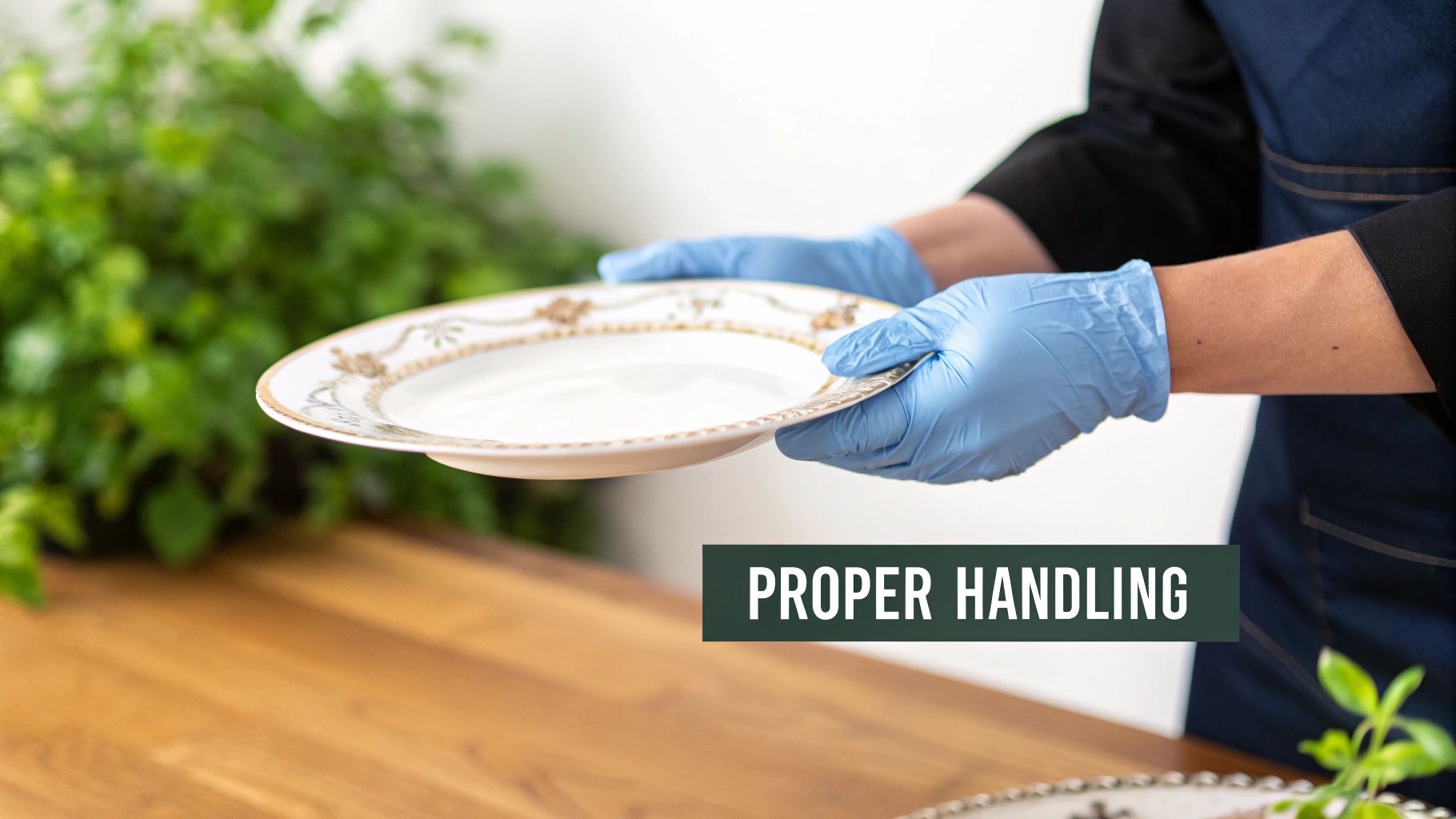
A big one is whether the number stamped on the back is the pattern number. The answer is a classic "maybe." With newer china, that number is often the pattern identifier. Easy enough. But with older pieces, those numbers could mean anything—an internal code for the blank's shape, the specific decorator's mark, or even the production batch. So, don't assume it's the pattern number right away.
From Identification to Value
Once you've nailed down a pattern name, the next natural question is always, "So, what's it worth?"
Disclaimer: This guide provides information for educational purposes and should not be considered financial advice. For a formal valuation for insurance or estate purposes, you should always consult with a qualified professional appraiser.
A great starting point is to look up "sold" listings on eBay or check the retail prices on sites like Replacements, Ltd. Remember, value is a moving target. It comes down to the maker, how rare the pattern is, its condition, and what people are willing to pay for it right now. A single chip can significantly impact the price, so inspect each piece carefully. This research is how you can determine if your items are trash or treasure.
Figuring out if your china is the real deal is another key step. If a price or a backstory feels too good to be true, it’s wise to be skeptical. Learning how to spot fake antiques is a skill that's just as useful for ceramics as it is for furniture or art.
Porcelain vs. Bone China
You'll often see these terms, but what's the actual difference?
- Porcelain is a very hard, dense ceramic that's fired at scorching-hot temperatures.
- Bone China is a specific type of porcelain that includes bone ash in its mixture. This gives it that famous bright white color, incredible strength, and a beautiful translucency.
There's a simple trick to tell them apart. Hold a piece of bone china up to a light. You should be able to see a warm, gentle glow shining through it. Standard porcelain is much more opaque and won't have that same delicate quality.
